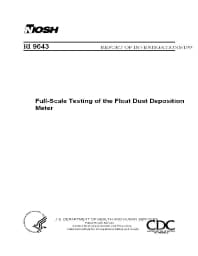Mining Publication: Full-Scale Testing of the Float Dust Deposition Meter
Original creation date: May 1998
Authors: RA Cortese, HE Perlee
NIOSHTIC2 Number: 20000051
Pittsburgh, PA: U.S. Department of Health and Human Services, Public Health Service, Centers for Disease Control and Prevention, NIOSH, DHHS (NIOSH) Publication No. 98-139, Report of Investigations 9643, 1998 May; :1-10
Coal dust and float coal dust, produced during normal mining operations, in underground coal mines, are carried from the point of origin downstream by the ventilating air, where the deposit on the surfaces of the mine entry. In an explosion, this dust is lifted from the surfaces by the aerodynamic disturbances and, if of sufficient quantity, can continue to propagate the explosion. To prevent the surface coal dust from contributing, it must be inerted, typically by spreading pulverized limestone, i.e., rock dust, over the coal dust surface. To facilitate the dusting operation, the National Institute for Occupational Safety and Health (NIOSH), Pittsburgh Research Laboratory (PRL), developed an automated system that continuously monitors the accumulation of coal dust. This system could activate a rock-dusting machine that disperses rock dust into the ventilation air when dangerous deposits accumulate and deactivate the machine when sufficient inert has been deposited on top of the coal dust. The system consists of a microprocessor-controlled optical float dust deposition meter. This device measures the light intensity reflected from a deposited layer of dust. A standard cap lamp is used as a fixed-position light source. From the reflected light signal, the microprocessor determines the hazard level of the deposited layer and performs the appropriate action.

NIOSHTIC2 Number: 20000051
Pittsburgh, PA: U.S. Department of Health and Human Services, Public Health Service, Centers for Disease Control and Prevention, NIOSH, DHHS (NIOSH) Publication No. 98-139, Report of Investigations 9643, 1998 May; :1-10